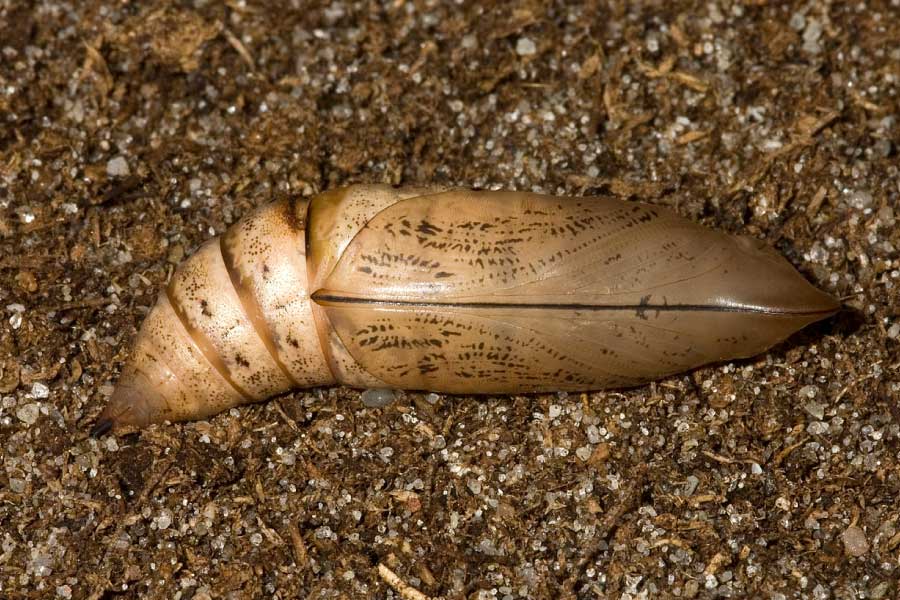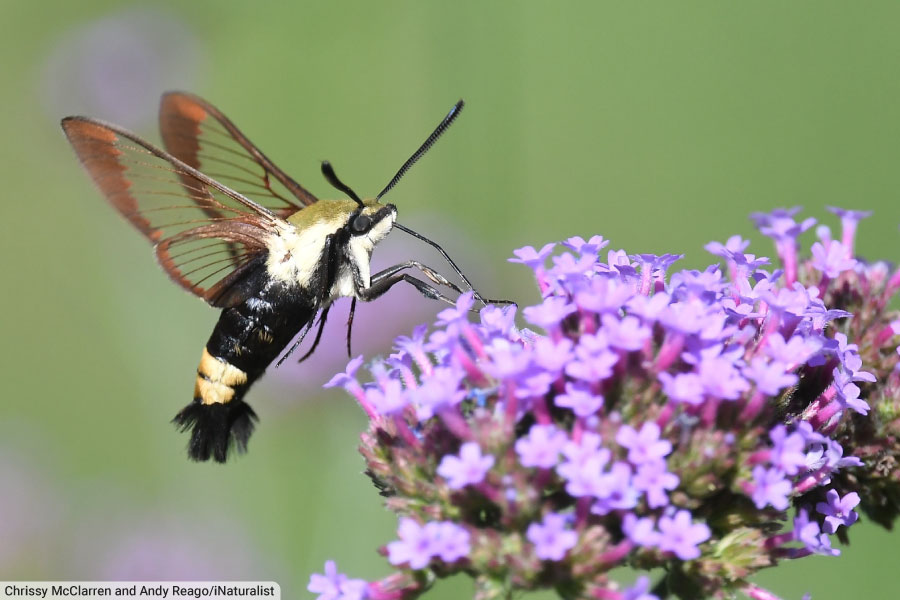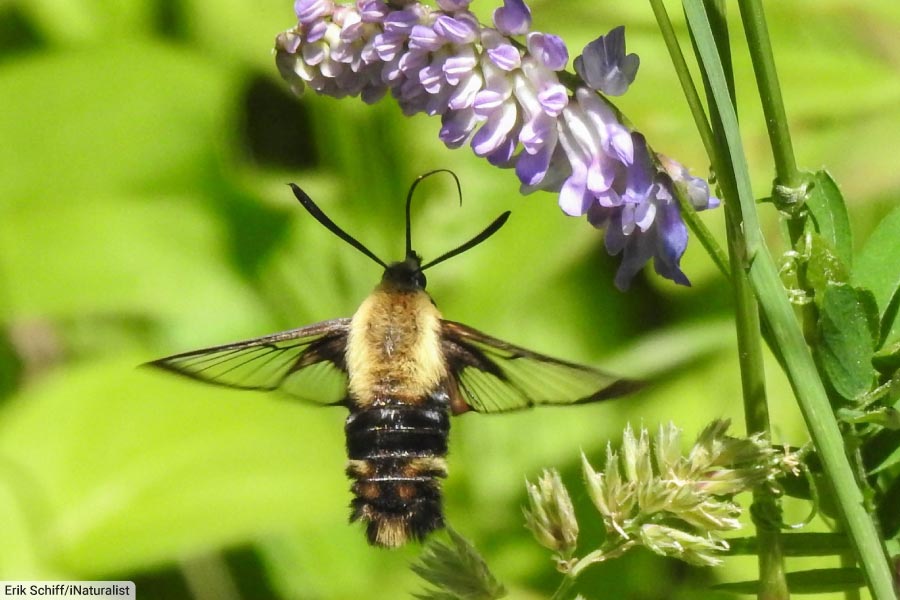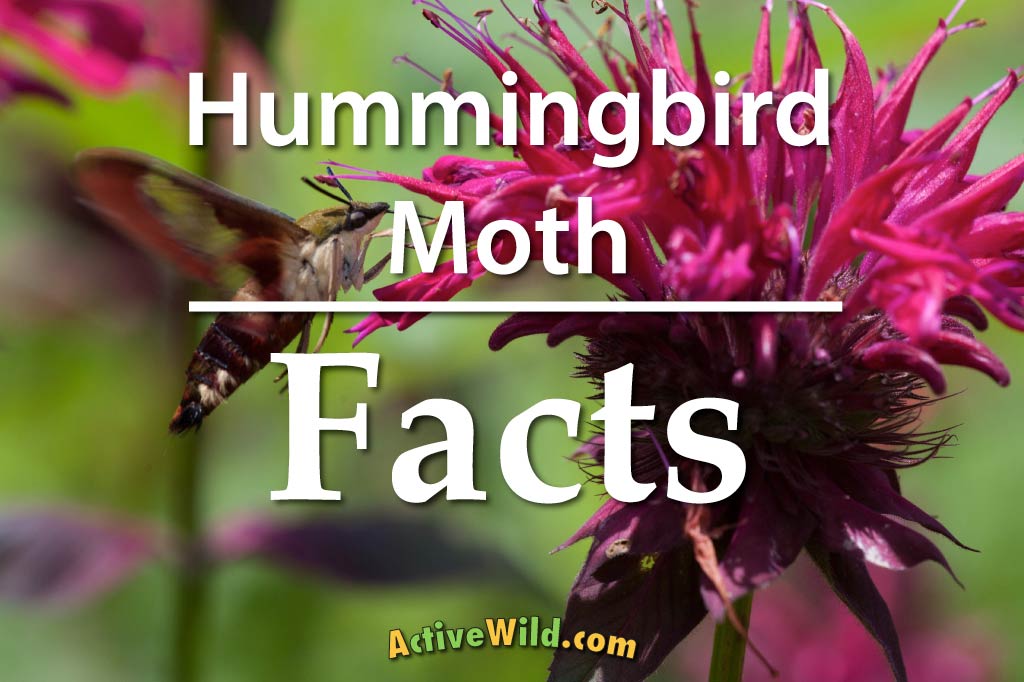As they dart from flower to flower in search of nectar, not only do hummingbird moths look like the birds after which they are named, but they also sound like them; the rapid flapping of their wings making a hummingbird–like buzz.
This page contains hummingbird moth facts, pictures and information. First we’ll find out about hummingbird moths in general before turning our attention to the five species of hummingbird moth found in the United States.
Finally, we’ll take a look at the related hummingbird hawk-moth, a species found in Europe (including the UK), Africa and Asia.
Have you seen a hummingbird moth? Report your sighting in the comments section at the bottom of the page!
Page Index
- What Is A Hummingbird Moth?
- Hummingbird Moth Facts
- Identifying A Hummingbird Moth
- Hummingbird Moths Found In North America
- Hummingbird Clearwing (Hemaris thysbe)
- Snowberry Clearwing (Hemaris diffinis)
- Slender Clearwing / Graceful Clearwing (Hemaris gracilis)
- Rocky Mountain Clearwing / California Clearwing (Hemaris thetis)
- White-Lined Sphinx
- Hummingbird Hawk-Moth (UK species of hummingbird moth)
- Discover More With Active Wild
What Is A Hummingbird Moth?
A hummingbird moth is one of a number of species in the sphinx moth family, Sphingidae, that resemble hummingbirds due to their size, hovering flight style and nectar-gathering behavior. Most of the moths known as hummingbird moths are members of the genus Hemaris.
Some sphinx moths commonly known as hummingbird moths are not of genus Hemaris. These include the white-lined sphinx moth Hyles lineata (found in Central and North America), and the hummingbird hawk moth Macroglossum stellatarum (found in Europe, Asia, and northern Africa).
You can see different species of hummingbird moths further down the page, including the five species found in North America.
You can find out what terms such as 'genus' and 'family' mean on this page: Animal Classification.
The hummingbird moth in the video below is a hummingbird clearwing moth, Hemaris thysbe. This species is found across much of the United States and southern Canada.
Species
In total, there are 23 species of genus Hemaris (source: Catalog of Life). The sphinx moth family, Sphingidae, which contains Hemaris and other hummingbird moths, contains 1,605 species (source: Catalog of Life).
How To Recognize A Hummingbird Moth
In general, hummingbird moths are easy to recognize due to their size, flying style, daylight activity and nectar-gathering behavior. (Photographs of all North American species can be seen further down the page.)

Movement
Hummingbird moths are agile fliers, able to hover in one spot as well as fly backwards and sideways. Their rapid wing movements make a humming sound much like that made by a hummingbird.
Due to their size and flying style, the moths can be mistaken for hummingbirds, hence the name “hummingbird moth”.
Size
Hummingbird moths are large moths, with a typical wingspan of 40 - 55 mm (1.6 - 2.2 in.), and body length of 30 to 51 mm (1.2 - 2 in.)
Appearance
Hummingbird moths have thick, bumblebee-like bodies, long wings and a long proboscis (a long, hollow mouthpart used to drink nectar).
The coloration of hummingbird moths varies from species to species; common colors include olive green, rusty reddish brown and yellow. The colors on the animal’s back and underside are often different. Many hummingbird moths have horizontal bands or other markings on the body.
Clearwing Moths
Hummingbird moths of genus Hemaris are also known as clearwing moths on behalf of their mostly transparent wings. Although the wings of clearwing moths are initially covered in scales (like those of other moths), after the first few flights the scales fall off, leaving the wing panels transparent.
Some hummingbird moth species, such as the olive bee hawkmoth Hemaris croatica found in Europe and the Kashmir bee hawkmoth Hemaris Rubra found in Asia, don’t have clear wings.
Day Flying Moths
Unlike most moths, hummingbird moths tend to be most active during the day or around dusk. June and August are often peak months for activity. They are most often seen hovering and darting from flower to flower in their search for nectar.
Some hummingbird moth species, including the hummingbird clearwing, are migratory.
Antennae & Proboscis

Hummingbird moths have a pair of long, club-like antennae that usually widen towards the end. The proboscis is around twice the length of the body and is kept tightly coiled when not in use.
Hummingbird Moth Habitat
Hummingbird moths occur in a wide variety of habitats, but are most commonly found in meadows, cultivated gardens and suburban areas.
Food Plants
Plants commonly eaten by moths of genus Hemaris include those of the teasel family, Dipsacaceae, and the honeysuckle family, Caprifoliaceae.
Which Hummingbird Moth Species Are Found In North America?
Four hummingbird moths of genus Hemaris are found in North America:
- Hummingbird clearwing (H. thysbe)
- Snowberry clearwing (H. diffinis)
- Slender clearwing (H. gracilis)
- Rocky Mountain clearwing (H. thetis)
In addition, the white-lined sphinx moth (Hyles lineata) – a hummingbird moth of genus Hyles – is found in North America.
Scroll down the page or click here to see each of the five U.S. species of hummingbird moth in greater detail.

In Europe, moths of genus Hemaris are more commonly known as bee hawk-moths. There are three species present in Europe.
The hummingbird moth found in the UK is the hummingbird hawk-moth (Macroglossum stellatarum). The species, which is also found throughout mainland Europe and parts of Africa and Asia, is not a member of the genus Hemaris, although it is in the sphinx moth family, Sphingidae. You can read about this species in greater detail further down the page.
Hummingbird Moth Life Cycle
Like all butterflies and moths, a hummingbird moth goes through four developmental stages during its life: egg, larva, pupa and imago (adult).
Hummingbird moths breed during the summer. The female produces pheromones to attract a male, and after mating, she finds a suitable host plant on which to lay her eggs. The eggs are usually deposited on the underside of a leaf.

After hatching, the caterpillars feed until they reach their full size (usually within a couple of weeks). They then make their way to the ground where they pupate, forming a cocoon under leaf litter or buried in the soil.
In colder areas, a single generation is produced each year; in warmer areas, two or three generations may be produced in a year.
Depending on the species, an adult hummingbird moth may live as long as seven months or as little as three weeks.
Hummingbird Moth Caterpillars

Hummingbird moth larvae (caterpillars) are among several types of sphinx moth caterpillars known as hornworms due to the horn-like spike that projects from the rear the body.

Hummingbird moth caterpillars should not be confused with the plant-damaging tomato hornworm or tobacco hornworm, which are the larval forms of the five-spotted hawkmoth and tobacco hawk moth respectively.
The eggs of hummingbird moths are tiny, round, and glossy pale green in color. The cocoons of most species have a glossy surface.
What Do Hummingbird Moths Eat?
Hummingbird moths feed on nectar, often seeking out the same long-necked flowers as hummingbirds.
The moths are particularly attracted to plants in the honeysuckle family, including viburnum and snowberry. They also feed on the nectar of flowers such as horse mint, beebalm, phlox, verbena, dogbane, cardinal, red valerian, salvia, and buddleia (butterfly bush).
The caterpillars eat leaves and are more restricted in their choice of diet than the adult moths. The primary host plants are hawthorns, cherries, honeysuckles, snowberries, teasels and dogbane.
Are Hummingbird Moths Endangered?
None of the hummingbird moth species have been listed by the IUCN as endangered. However, some species may be in decline locally. For example, the slender clearwing (H. Gracilis) is considered threatened in Connecticut.
Hummingbird Moths Found In North America
Hummingbird Clearwing (Hemaris thysbe)

The hummingbird clearwing is a species of hummingbird moth found in the United States and Canada. It is found in Alaska, across Canada, and throughout the eastern United States to Texas and Florida.
The species typically has an olive green head and thorax, burgundy abdomen, and pale undersides, although colors vary between individuals.

The wings have clear central panels and brown / burgundy / olive green edges. The species’ wingspan is 4 - 5.5 cm (1.6 - 2.2 in)
The hummingbird clearwing can be differentiated from the snowberry clearwing by its pale yellow legs, and by the lack of banding on the side of the thorax.
Snowberry Clearwing (Hemaris diffinis)

The snowberry clearwing is named after the snowberry plants on which the caterpillar feeds. The snowberry clearwing’s coloration varies from individual to individual, but the thorax is typically gold or olive-gold, and the abdomen black with one or two yellow / gold segments near the end.
The gold / black coloration of the snowberry clearwing means that it can easily be mistaken for a bumblebee.

The species is most abundant in the Eastern United States and the southeast of Canada, although it has been seen both in California and Alberta, Canada.
The snowberry clearwing can be distinguished from the hummingbird clearwing by the black stripe that stretches from the insect’s head, across the eye and under the wings on the thorax, and by its black legs.
Rocky Mountain Clearwing / California Clearwing (Hemaris thetis)

As its name suggests, the Rocky Mountain clearwing is found in the western United States. Its range stretches from southwest Canada to northwest Mexico.
The species’ coloration is varied, but typically the head and thorax are olive-green and the abdomen is black with one or more adjacent yellow / gold segments.
Slender Clearwing / Graceful Clearwing (Hemaris gracilis)

The slender clearwing is very similar to the hummingbird clearwing, having an olive head and thorax and burgundy abdomen.
The slender clearwing can be identified by the thin white band around the abdomen where it meets the thorax; the red-brown stripe running along the side of the thorax from behind the eye and under the wings to the abdomen; and the red-brown color of the upper surface of its legs.
The species is mainly found in the eastern United States.
White-Lined Sphinx (Hyles lineata)

With a wingspan of between 2 and 3 inches, the adult white-lined sphinx is larger than the hummingbird moths of genus Hemaris found in the United States. It is also more likely to be seen flying at dusk and during the night than the day-flying clearwings.
In the video below, a white-line sphinx moth can be seen flying from flower to flower in search of nectar.
The species' long forewings are dark brown and black, with a white central stripe and several thinner cross-stripes. The hindwings are black with a wide pink central stripe. The abdomen is marked with several white and black stripes.
The white-lined sphinx is found throughout the United States as well as in southern Canada and Central America.
Other Hummingbird Moths
Hummingbird Hawk-Moth (Macroglossum stellatarum)

The hummingbird hawk-moth is a sphinx moth found in Europe, Asia, and Africa. It is similar in appearance to hummingbird moths (although it does not have clear wings), but is not in the genus Hemaris. Instead, it belongs to the genus Macroglossum, which means "long tongue", referring to the insect's long proboscis.
In the UK, the hummingbird hawk moth is seen from late spring to early autumn. It has orange-brown wings, grey head and thorax, and black abdomen with white patches. The undersides of the head and thorax are white / grey. The wingspan ranges from 50 to 58 mm.
As its name suggests, the hummingbird hawk moth resembles a hummingbird when foraging, as it hovers, and darts sideways and backwards as it flies from flower to flower. Like the hummingbird moths of genus Hemaris, it also makes a humming sound when flying.



Do they migrate or travel long distances? I live in the Sicilian countryside. And in late February early March I see one or two and then no more. I think they are the Hummingbird Hawk Moth. This year I saw and heard one hovering around the blooming almond trees. I am pretty sure they are not Hummingbirds as I used to see them in the US.
Thank you
Hi Rosa,
Yes, hummingbird hawk moths are migratory; those we see in the UK are generally from Central or Southern Europe. However, in Sicily we’d have thought it was warm enough for them to overwinter. Perhaps you are seeing the first generation before they disperse northwards?
(They definitely aren’t hummingbirds as they (the birds) are only found in the Americas.)
Thank you for you message.
Regards,
The Active Wild Team
yes I saw one today. I’ve never seen one. Beautiful . I took a picture.
A hummingbird hawk moth flew into the house yesterday afternoon and spent the night settled on the lounge wall.
He’s just flown back off out through the kitchen to the garden. Beautiful 😍
This weekend we saw a hummingbird hawk moth feeding on buddleia (butterfly bush) in Bexhill, on the south coast of England, at around 6.30 pm. Other onlookers were impressed by its size and unique flying style.
We’ve also seen several on holiday near Bordeaux, France (including three this morning!) 🙂
just got video of a humming bird moth drinking at a hummingbird feeder and a hummingbird checking him out!
Hi
Just seen my first ever White-Lined Sphinx (Hyles lineata) here in grand junction ,iowa . They are so cool looking at first I did think it was a hummingbird till I started to look them up . Is it normal for them to be out at noon during the day ? Hope to see more .
Hi Diane,
Congratulations on seeing your moth. Yes, it’s normal to see a white-lined sphinx during the day, although this particular species is generally more active at night.
Regards,
The Active Wild Team
Normally I see one of these per summer. But this summer they been around almost daily and just noticed a few of them feeding off my hostas here at dusk. Have not seen them at dusk. I always see them during day. My garden was the best it’s ever been this year and between all the birds, moths and butterflies it’s shows! Can’t wait for what next year brings!
Hi,
Thank you for your message, it’s great to hear that hummingbird moths have been paying regular visits to your garden!
Let’s hope you get even more next year!
Regards,
The Active Wild Team
have lots here in galicia in our garden
I’ve been seeing multiple hummingbird moths in Windsor, CA, Sonoma county.
I just saw my first hummingbird moth, a white-line sphinx. It was spending time in our lavender bushes. I got a few slo-mo videos and some pictures. Hoping it becomes a resident. Park City, UT at dusk, 13Aug23.
Seen several today at our local Home Depot garden center. So interesting and fun to watch.
I enjoyed watching a clear wing hummingbird moth today. It buzzed around my petunias for about 15 minutes. I wish I could share with you the amazing photos I got.
I live in rural upstate New York. I believe I saw this today because we finally had some sunshine 😁
Spotted a clear wing hummingbird moth enjoying my thistle & Wild bergamot. Absolutely beautiful! (Ladysmith, WI on 7/21/23)
Wonderful! Thank you for letting us know.
Regards,
The Active Wild Team
My daughter and I were on a Rhone River Cruise, France and found a Hummingbird Moth in the lavenders at the Smallest Cathedral of Viviers! Have videos and photos!
Hi,
What a great sighting in a beautiful part of the world. Thanks for letting us know!
Regards,
The Active Wild Team
just visited by two white wing sphinx humming bird moths for the first time, so exciting! Medford, Oregon 9:30pm on Red Verbena and Sunset Rose Lantana
That’s great to hear, thank you for reporting your sighting!
I just saw my 1st real life Hummingbird Moth! It flew up right next to me on the porch and enjoyed the nectar from my petunias! I was able to get several pictures and a video. After do a little research I discovered that it was a white-lined sphinx moth! So cool! Middleton, Idaho
Congratulations! Thank you for letting us know! 😀
Regards,
The Active Wild Team
Found one today in Caldwell Idaho. It really was cool to watch. I took a picture because I had never seen such a fat bodied hummingbird before but it was a White-lined sphinx moth
Congratulations, and thank you for letting us know!
Saw one last night in Portageville, Mo. on my petunias. Tried to get a picture but she was too fast. Beautiful!!
I saw one! In Southern New Hampshire. Green and burgundy. It was visiting our dandelions. Probably wouldn’t have noticed it were it not for the sound of it’s wings.
Awesome! Thank you for letting us know!😀
I just saw my first one. I never even knew they existed. Interestingly, I had just peeled a cucumber earlier, but it actually appeared to be feeding some fish skeleton from our dinner last night. I did get it on video.
Congratulations!👍 Where are you located?
We have had about 7-8 hummingbird moths on our honeysuckle for several days. Very active feeding in Denton, Texas.
We recently saw a hummingbird hawk-moth here in East Sussex, England. This was the European relative (Macroglossum stellatarum) of the North American species covered in the article. First week of April was very early for it to be out, we hope to see some more during the year.
We love hearing about your sightings, so please keep them coming in, wherever you are in the world!
The Active Wild Team
I just saw one of these magnificent creatures in Topanga mountains right by Los Angeles, CA! Such a fascinating one, as there are a lot of hummingbirds here as well. Very curious why they evolved to resemble hummingbirds so much.
Hi Lina,
Congratulations on your sighting, and thank you for letting us know!
The reason that hummingbird moths and hummingbirds resemble one other is likely a case of convergent evolution – over millions of years, the two unrelated groups of animals (moths and birds) eventually ended up with the same kind of adaptations for a nectar-gathering lifestyle.
Regards,
The Active Wild Team
Last July I had several of the larva in my flower bed. I live in Northern Wisconsin and had never seen the likes of the very hungry creatures. I waited to see moths and never saw a single one. Do the pupa overwinter? How long do they stay in the pupa stage?
Hi,
Thank you for your comment. Congratulations on attracting the larvae to your garden, and sorry you didn’t see the adults!
Both the hummingbird and snowberry clearwing overwinter as pupae. The cocoon is spun at ground level in soil or in leaf litter. The adult moth emerges in late spring.
In most non-northerly areas there are two or even three generations per year; those generations that aren’t overwintering will pupate for 2 to 4 weeks.
We hope this helps, and that you see some adult hummingbird moths this year!
Regards,
The Active Wild Team
Saw one at the Grand Canyon this summer!
Last night we had four of them together in the lantana. We have hummingbirds in the lantana and hamelia everyday, but this was dusk and I have never seen a hummer that late. My husband and I stood still next to the lantana and watched them for about 5 minutes. They darted around the plants, dipping into all the flowers. They flew right next to us and around us and didn’t seem to even notice us. They worked their way down the garden in a small group. It was amazing. Thank you for offering this great information so we could figure out what we were seeing! We are in Sugar Land Texas. It is a suburb just south and west of Houston, TX.
Hi Tracee,
What a great sighting! Thank you for sharing.
Regards,
The Active Wild Team
Saw my first Hummingbird Clearwing moth in Tampa, Florida. Wecat a beautiful creation from our Lord.
Hello All,
We just saw a Hummingbird Moth in Western Oklahoma!! Based on the photos in this article, it looks to be a Snowberry Clearwing. We have lots of hummingbirds out here and have never really paid attention, but we could tell this looked a little different. It was really neat to see, so of course we had to take pictures.
had a White-Lined Sphinx this morning in our garden, Rogers City Michigan, great to catch a glimpse and pics 🙂
We’ve discovered several clear wing hummingbird moths in our gardens. They are very active, carefully going from flower to flower. I have never seen them before, maybe I mistook them for hummingbirds, but we have them too! We are in the suburbs of Philadelphia, Pa. Donna
Hi Donna,
That’s great! Thank you for sharing your sighting, it’s much appreciated.
Regards,
The Active Wild Team
We saw one in Shakespeare Ontario Canada on August 15th.
Had one this morning (Aug 15, 2022) on my mauve phlox. Not sure if it was a yellow or clear wing. Did not know there were different types until it was gone. I am in Vanderhoof, BC, Canada.
August 26 2022. Springwater Sask near Biggar. White-Lined Sphinx Moth feeding on milkweed plant@dusk. Many people checking it out an oddity in our area not intimidated at all – approached within 4 feet.
Many thanks for sharing your Canadian sightings, it’s very interesting hearing where these moths can be seen.
Regards,
The Active Wild Team
Sighted a sphinx hummingbird moth this evening enjoying our pansies. Beautiful little guy. We are in northern Michigan
I had a lovely clearwing on our butterfly bush this morning, along with viceroy and white admiral butterflies. We are located in Sheboygan County, WI. I have posted a picture on my Facebook page at The House at the End of the Road.
Found a humming bird moth resting, missed the flying because I didn’t want to disturb it. Way up here Renfrew Ontario, Canada. Very interesting to see. Not something a lot of people get to see in a life time here
Hi Joan,
Many thanks for your message, it’s great to hear where these moths can be seen.
Regards,
The Active Wild Team
I feel certain that I saw a hummingbird moth on verbena flowers on my patio, at dusk , a week ago. I line in Hertfordshire UK
Hi Pat,
That’s great sighting, thank you for letting us know!
Regards,
The Active Wild Team
We have hummingbird moths here every year in Rochester Hills, MI. They love my monarda and Sweet William. After reading your helpful article, i believe they are hummingbird clearwings and snowberry clearwings. I am somewhat confused, however, by one of your references in the article. Early in the article, the chrysalis color is mentioned. Don’t all moths cocoon rather than become a chrysalis? I have always read that only butterflies form chrysalides.
Hi Tammy,
Thank you for letting us know about your hummingbird moths.
You’re right, we should have said cocoon rather than chrysalis. We’re not sure how that slipped through; thank you for bringing it to our attention!
Regards,
The Active Wild Team
Spotted today my first hummingbird, it moves so fast that most pictures I took were useless, but I’ve got a video. It looks like the one in the first video above “hummingbird clearwing moth, Hemaris thysbe.” My cats were very surprised but were smart enough not to engage it. Omaha, NE 8:20pm.
Congratulations on your sighting, and thank you for letting us know!
Regards,
The Active Wild Team
I was mowing the lawn and this big bee hummingbird looking thing keep hovering in front of me. It wouldn’t stop for sometime . I didn’t know if it was angry or friendly.
We saw our first hummingbird moth yesterday, in my hummingbird/butterfly garden. At first we didn’t know what it was, as I had never seen one before. It had characteristics of a hummingbird but much smaller. It looked almost like a bumble bee, but it hovered over the butterfly bush collecting nectar. After some research we found that it was indeed a Snowberry Clearwing. We were able to get a very good picture of it. Later that evening we had a much smaller one, but darker one appear. Indianapolis, Indiana
Hi Terri,
Congratulations on your sighting, and thank you for letting us know!
It’s great to hear that your garden is attracting wildlife.
Regards,
The Active Wild Team
I live in Western Ky & I just took some photos of what I guess to be a Hummingbird Moth sipping on my Phlox. I usually see them yellow/black coloring sorta like a ugly (sorry) wood bee. However today’s little one had 2 lime green bands on it’s lower back & didn’t seem to have a curled tongue but rather a short straight bill. Do you think that’s what I saw or what variation?
I live in the country of Turkey. I love hummingbirds as I am from Louisiana and we put out feeders to attract hummingbirds. To my surprise last year, while sitting near my kitchen window, I thought I saw a tiny hummingbird but to my surprise it was a hummingbird moth. It was too fast for us to capture a picture but this year my husband did catch it with his iPhone. I do not know how to send it to you but I will if you instruct me how to do this.
Sincerely,
Shirley Akis
Thank you for your message – it’s fascinating to hear about wildlife from other parts of the world. Have you any idea of the species?
Unfortunately we can’t accept video at present – perhaps you could upload the footage to YouTube?
Thank you again for the message, and we hope you see the hummingbird moth again!
Regards,
The Active Wild Team
My first time seeing hummingbird moth, it was freaky and beautiful, I was also watching hummingbird feed at same time what beauty before our eyes.
Got a photo.
Hummingbird or moth?
https://imgur.com/a/bBov6eY
Seen in southern Alberta, Canada
August 6, 2021
Hi,
That’s a white lined sphinx moth.
Regards,
The Active Wild Team
We were delighted to discover a Snowberry Clearwing Moth feeding on our petunias as we were deadheading them today. Certainly surprised us! But was a nice treat and very fun to try to identify our visitor. We are in central Michigan and while we have had a number of actual hummingbirds over the years this is the first hummingbird moth we have noticed. Our flowers are especially beautiful and fragrant this year. Hopefully we will be able to see this hummingbird moth again and perhaps get some pictures!
That’s great! Hopefully the first of many!
Regards,
The Active Wild Team
My husband had a sighting this afternoon in West Michigan, his first known encounter! He snapped a picture and I googled it and low and behold…a Hummingbird Moth!
Today I was delighted to see a Hummingbird Moth. I don’t what species it is. I haven’t seen a picture of the moth I saw. I am sorry I didn’t have my cellphone and wasn’t able to take a video of the Hummingbird Moth I saw. It was black and had small white dots on the tail.
Hi Linda,
Congratulations on your sighting! Hopefully you’ll have your phone next time!
Thank you for your message,
The Active Wild Team.
I’ve had a hummingbird moth appear now and then in my phlox. I thought for the longest time it was a hummingbird until a closer look revealed that was not the case. What a magnificent creature! It generally comes towards evening and so infrequently I’ve only seen it a couple times a summer. It is such a wonderful blessing to observe this creature darting between the lovely phlox, drinking nectar.
Thank you for letting us know about your visitor! We really appreciate it when readers report their sightings!
Regards,
The Active Wild Team
I’m not at all sure what I saw, but it flew and sounded a lot like a hummingbird. I was sitting up in my bed watching tv, when this weird thing buzzed into my room and continued flying, somewhat slowly, across the room to the corner where I have stacked wooden cubes. It didn’t pay any attention to me. It scared me. It looked as if as a baseball from behind, wings were mainly brown with black markings and a large red area in the middle of its lower body just under the wings. The wing span looked approx 3 inches wide, at least, and the wings looked connected in the middle of its back and not at the sides of its body. The body looked about 4 inches long. I didn’t see the front of it at allIt seemed to know where it was going. I had moved in November with one extra large box of clothes and shoes that had been in storage. I know it wasn’t here when I moved in. I’m sorry, I haven’t seen it again, but I’ll try to get a picture or video, before I call pest control. It did look much bigger than any of the pictures I looked at, but the description fit, for the back side. Please let me know if there are any larger moths like this. Thank you,
Linda
Hi Linda,
Thank you for your comment. Your mystery animal sounds too big to be a moth, so we strongly suspect that it was a hummingbird. We don’t know of any other larger moths that can hover in this way.
Hopefully if it appears again you’ll be able to get a look at the front to see whether or not it has a bill.
Regards,
The Active Wild Team